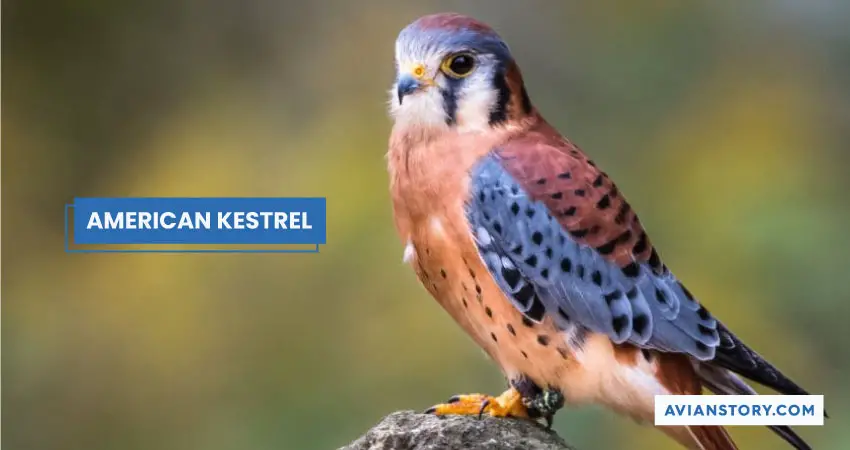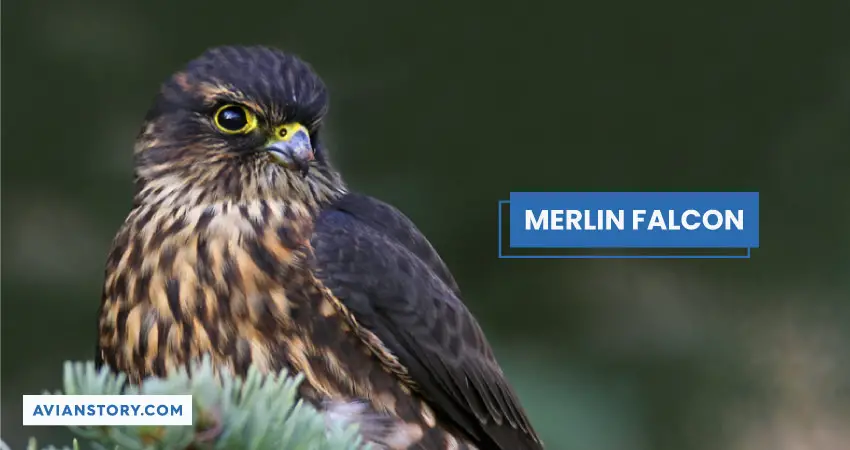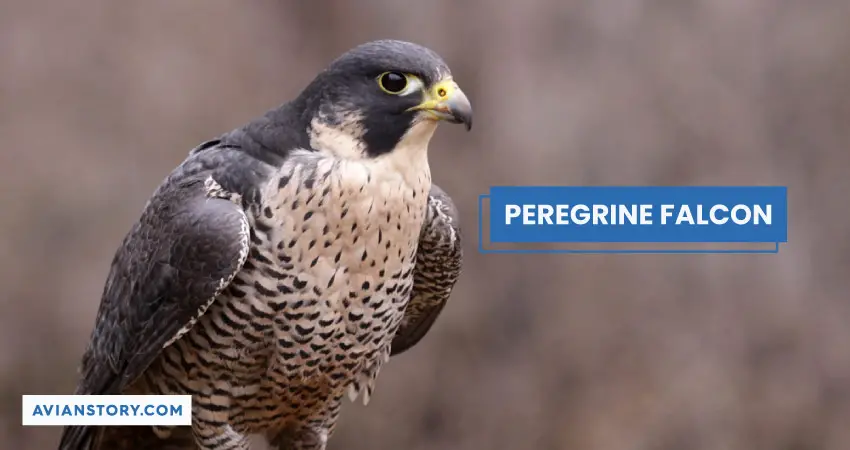Falcons in Pennsylvania [3 Species With Pictures]
In the Commonwealth of Pennsylvania, falcons are not a rare sight. The state is home to 3 types of falcons, with the most common falcon being their smallest raptor, namely the American Kestrel.
The other two falcons you might catch are Peregrine Falcons or Merlins.
While the general attributes of falcons command respect for these birds of prey, their specific traits are just as awe-inspiring. We’ll learn more about the Falcons in Pennsylvania below.
Different Species of Falcons Found in Pennsylvania
If you are in Pennsylvania, you will surely spot a falcon around. As we mentioned, the 3 types of falcons that stay in Pennsylvania are present in good numbers and, therefore, easily spotted.
American Kestrels, the most common and smallest of the three, can be seen all year round in all areas. These raptors like to stay close to empty grounds when loitering around and perched on top of high places when looking for prey.
Merlins, on the other hand, are not residential birds. They can’t be found the whole year round, and they are seen while seasonally migrating to Canada or Atlantic Coast.
These raptors are not so easily seen because they tend to maintain positions in high treetops while not chasing their prey at top speed in mid-air.
Peregrine falcons migrate and also inhabit Pennsylvania. They reside along the Ohio River and also on the southeast side of the state.
As per their chosen habitat, they have a keen interest in hunting near water bodies. Peregrine falcons also keep a special eye out for flocks of pigeons around them.
| Falcons of Pennsylvania | |||
| Characteristics | American Kestrel | Peregrine Falcon | Merlin |
| Primary Food | Rodents, insects, small birds | Birds | Bohemian Waxwings and House Sparrows |
| Flying Speed | 22-39 mph | 25 – 34 mph | 30 – 43.5 mph |
| Breeding Season | Early Spring – Late Summer | Early April – July | May – June |
| Conservation Status | Stable/ Least Concern | Low Concern | Stable/ Least Concern |
Let’s take a closer look at the 3 falcons frequented in Pennsylvania.
1. American Kestrel (Falco sparverius)

- Length: 9 -12 inches
- Weight: 80–143 g (Male) and 86–165 g (Female)
- Wingspan: 21 inches
- Commonly Found In Open areas and tall trees
Let’s begin by getting to know the American Kestrel, which is by far the most common falcon to be sighted in Pennsylvania.
Appearance
These birds have a stubby build and small vertical black bands on both sides of their mouth and face, which give them the appearance of mustaches and sideburns.
One differentiating factor between the male and the female is that the males have slate-blue wings, whereas the females have a reddish-brown set of wings.
Diet
The friendly appearance of these American Kestrels should not deceive you. American kestrels are, in fact, very ambitious in hunting.
With a great reserve of ruthless force in them, they eat everything from mice, snakes, scorpions, bats, and rodents to invertebrates and insects such as grasshoppers, beetles, dragonflies, and so on.
General Behaviour
American Kestrels snatch their prey right up from the ground by flying into them in a graceful motion with their sharply pointed wings that cut through the air at speeds of up to 39 mph.
These birds employ multiple methods to catch their prey. First of all, kestrels will spend a lot of time watching their prey from a distance. After they set a target, they will use one of two hunting methods.
One method is to float above the prey while facing the wind directly and beating their wings.
When they are ready to catch it, they fold their wings and come swooping down to grab their prey in their talons. Another way to hunt is a fast-speeding approach where the raptor flies right down to the prey and grabs it mid-flight.
While American Kestrels are no doubt ferocious, they are in fact, quite small, due to which they are likely to fall prey to larger birds of prey like hawks and owls.
The characteristic mechanism to avoid this is to employ a noisy and violent demeanour towards other raptors that it perceives as threats.
Mating Season Behaviour
The male American Kestrels perform for their females like in many bird groups. They will climb up their branch and then take a dive while singing out in small spurts when they are at the summit of their ascent.
To court the female, the male provides some food to the female as a gift. One way for the male American Kestrel to exhibit their eligibility is to mark and protect their territory.
This is why the small raptors can be seen fighting off hawks and eagles or to fight off smaller competition to secure a nesting cavity of their choice.
Conservation
Although American Kestrels are widespread in Pennsylvania right now, they were even more so in the past.
Records from Breeding Bird Surveys on North American birds suggest that their numbers have fallen by 1.41% every year since 1966, amounting to a net decrease of 53% in the American Kestrel population of this day.
However, this is a natural consequence of passing time and not a big concern for conservation as the breeding population of the American Kestrel is 9.2 million globally, which is quite a safe number to be at.
One threat to its livelihood is the use of chemicals and pesticides in farmlands. On top of this, deforestation also ruins the habitat of these birds, leading them to stay exposed to big prey for longer periods of time and risk their lives.
Interesting Fact on American Kestrels
Besides being the tiniest raptors in the region, American Kestrels are also the most colourful birds that hunt in bright daylight. They have an excellent vision that allows them to see even against bright and blinding sunlight.
2. Merlin (Falco columbarius)

- Length: 25 – 33 cm
- Weight: 55 – 69 cm
- Wingspan: 105–165 g (Male), 145–230 g (Female)
- Commonly Found In: Old birds’ nests, tree cavities, on a ledge, and open woodlands
Now let’s get to know the merlins in-depth!
Appearance
Merlins are larger than the American Kestrels. These raptors are built powerful with a broad chest, medium-sized tails, and wings that are sharply pointed.
Merlins are not as colorful as the American Kestrels; they are actually quite dark in color, with shades of brown and grey as the identity for their family units. Females and young Merlins are usually brown, while fully-grown male Merlins are grey in color.
However, as a general rule of color identity, raptors that live in the North, where the air is dry, are lighter in color than those that live in the South, where the atmosphere is more humid.
Merlins’ chests are streaked, and their underwings are very dark. Merlins have streaks on their chest and narrow white bands in their dark tail.
Many people confuse the appearance of an American Kestrel and a Merlin. Still, the difference can be very clearly noted in the fact that Merlins do not have any facial stripes, whereas American Kestrels, very noticeably, do.
Diet
The staple food items in their diet include birds that are small to medium in size, such as larks, house sparrows, and pipits. They also like to eat birds that are a bit larger than them, such as pigeons and sandpipers, along with other insects, reptiles, rodents and so on.
General Behaviour
Merlins have sharp pointed wings and a bulky build which allows it enough strength and buoyancy to fly at speeds of 43.5 mph through the air.
True to being a bird of prey, merlins like to work for their food before eating it. They have a few hunting styles that they employ for successful kills.
One of the ways is to catch prey mid-air in a quick swoosh after having observed it for some time. Another method is the surprise attack, where the raptor flies over the ground at a very low level and picks up prey from a very close range.
Merlins also practise keeping their food in reserve when it is found in abundance. Merlins are solitary birds, and they disperse family units to stay on their own when they are not on a mission for breeding, parenting, or otherwise.
Mating Season Behaviour
Merlins flock around in plains, prairies, or at the edge of the woods during mating season. These raptors form a couple for mating for the whole season, it is, in fact, a serial and seasonal monogamist. Merlins become mature enough to produce when they turn 1 year old.
Much like the American Kestrel, male Merlins try to attract female Merlins during the mating season with performance routines designed to catch attention.
A male merlin will showcase its flying styles in a display for the female to notice.
After the Merlin succeeds in catching the attention of a suitable female, it will present an offering of food to her. Once accepted, he will show her to a nesting site he has prepared for the season.
Female Merlins will lay about 2-5 eggs, which will take about a month to hatch. The hatchlings stay in the nest for another 30 days, and during this time, the mother and father falcon have a synergetic role in providing and feeding the young.
One-month-old Merlins are readied for independence with flying and skills training sessions, and after practising for another 2 months, the young 3-year-old Merlin will be ready to take on the world alone.
Conservation
By all facts and figures, Merlin populations in the world are currently not under any threat.
It has been declared a safe group by the IUCN. In every country of Merlins’ residence, these raptors are found in abundance with numbers between hundreds to thousands.
In North America, there were definitely more Merlins before than there are now, but the numbers are well in the safe range.
Interesting Fact on American Kestrels
Bonus Fact! Merlins are sporty birds that are popularly known as “Lady’s Hawk.”
These raptors were actually used in the sport of falconry during the Medieval Times by ladies of the court who used them for hunting Eurasian Skylarks and other birds of prey.
Some of the raptors’ fans are big names such as Catherine the Great and Mary Queen of Scots.
Another interesting fact is that Merlins are very entitled raptors. Did you know that they do not make their own nests?
They like to take over the nests of crows or other birds. They are so entitled to strangers’ nests that they would even lay an egg on top of the nest rather than the cavity.
3. Peregrine Falcon (Falco peregrinus)

- Length: 34 – 58 cm
- Weight: 0.7 – 1.5 kg (female) & 0.33 – 1 kg (male)
- Wingspan: 74 – 120 cm
- Commonly Found In: River valleys, mountain ranges, and coastlines
The Peregrine Falcon is the largest falcon of all in Pennsylvania. These falcons are widespread not only in Pennsylvania but also in the larger world.
Appearance
Fully grown peregrine falcons have a hint of blue and grey shades on their heads, and they also come with sideburns. Young Peregrine falcons, on the other hand, have vertical streaks in their chest.
These streaks are very striking, and they create quite an accurate representation of the quintessential bird of prey look. The raptor appears to be cruel and foreboding, but this appearance is not too apart from reality.
Every peregrine falcon has very pointed wings and a long tail. They can gain great mileage in a very short time due to a special technique to fold their wings and reduce the size of their body when they are in motion and move at 200 mph at top speed.
The bodily proportions of this raptor create the illusion that it is much bigger in size than it actually is.
Diet
These raptors have adjustable dietary needs. Owing to this, they can survive in big cities and suburbs. In the big city, these raptors are most often seen hunting pigeons.
If they are near the sea shores, these birds change their diet to include ducks and shorebirds. They will also eat large prey such as geese, songbirds, large gulls, some mammals, and even insects.
General Behaviour
Peregrine falcons employ a method called the “stoop” in order to fly through the air and grab birds in mid-flight. Peregrine falcons have incredible eyes for spotting prey from afar.
Once they set their target, they will keep a close watch on it from a distance and then abruptly make an attack when they see the perfect opportunity.
Also, as we have already mentioned, Peregrine falcons have the fastest flying speeds. The speed of Peregrine falcons during a general flight is 25 – 34 mph, and when in pursuit of prey, they will be flying at speeds of around 69 mph.
Mating Season Behaviour
Peregrine falcons mature in age within 2 years of their birth. During the mating season, an adult male will try to attract an adult female with the help of flashy courtship displays.
Peregrine falcons mate for life, so once a female Peregrine falcon makes a decision, the couple stays intact. Every year at a common time, the coupled Peregrine falcons will fly to their chosen nesting site and stay together for the whole mating season.
The Peregrine Falcons provide hatchlings during late March or the beginning of April.
Conservation
There was an incident between 1950 – 1970 when the number of Peregrine falcons were dropping, and the species was entered into the dreadful list of Endangered Species in 1999.
However, according to records in the North American Breeding Bird Survey, the numbers have now become stable.
The turnaround of the Peregrine population is due to the successful employment of environmental measures such as pesticide control.
With the current global population at 340,000, the population of Peregrine Falcons is stable enough for this species to be marked as a “Low Concern” species. This means that, for now, the Peregrine Falcon population is stable.
Interesting Fact about Peregrine Falcons
One interesting fact about this raptor is that it is the fastest animal in the world. They are also the most loyal raptors, as they keep one mate for life and return to the same partner every season for mating.
Conclusion
The Peregrine Falcon is the largest falcon in Pennsylvania, followed by Merlin and then by the American Kestrel. These birds of prey are extremely vicious due to their ability to rip off flesh if they perceive a threat.
Be very cautious when you are watching Falcons in Pennsylvania. Despite the general size and appearance, these raptors are very dangerous and aggressive creatures.
Falcons Found in Nearby States of Pennsylvania:
Resources:
- https://waterlandlife.org/peregrine-falcon-removed-from-threatened-species-list/
- https://www.pgc.pa.gov/Education/WildlifeNotesIndex/Pages/Hawks-and-Falcons.aspx
- https://www.smithsonianmag.com/science-nature/10-fun-facts-about-falcons-180962042/
- https://whatismyspiritanimal.com/spirit-totem-power-animal-meanings/birds/falcon-symbolism-meaning/
- https://www.birdsoutsidemywindow.org/peregrine-faqs/the-solitary-nature-of-peregrine-falcons/
- https://www.nps.gov/cabr/blogs/the-falcon-and-the-tiercel.htm
- http://www.biokids.umich.edu/critters/Falco_peregrinus/
- Hunting Methods: https://www.nhnature.org/visit/animal_info_sheets/kestrel.php
- Cool facts + Everything on all 3 falcons: https://www.allaboutbirds.org/guide/Peregrine_Falcon
